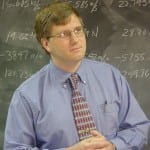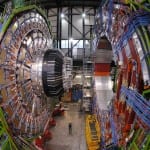“No significant signs of new physics with the present data yet but it takes only one significant deviation in the data to change everything.” — Albert De Roeck, CERN
First collisions of protons at the world’s largest science experiment are expected to start the first or second week of June, according to a senior research scientist with CERN’s Large Hadron Collider in Geneva.
“It will be about another six weeks to commission the machine, and many things can still happen on the way,” said physicist Albert De Roeck, a staff member at CERN and a professor at the University of Antwerp, Belgium and UC Davis, California. De Roeck is a leading scientist on CMS, one of the Large Hadron Collider’s key experiments.
The LHC in early April was restarted for its second three-year run after a two-year pause to upgrade the machine to operate at higher energies. At higher energy, physicists worldwide expect to see new discoveries about the laws that govern our natural universe.






De Roeck made the comments Monday while speaking during an international meeting of more than 250 physicists from 30 countries on the campus of Southern Methodist University, Dallas.
“There are no significant signs of new physics yet,” De Roeck said of the data from the first run, adding however that especially SUSY diehards — physicists who predict the existence of a unique new theory of space and time called SuperSymmetry — maintain hopes of seeing evidence soon of that theory.
De Roeck in fact has high expectations for the possibility of new discoveries that could change the current accepted theory of physical reality, the Standard Model.
“It will take only one significant deviation in the data to change everything,” De Roeck said. “The upgraded machine works. Now we have to get to the real operation for physics.”
“Unidentified Lying Object” not a problem — remains stable
But work remains to be done. One issue the accelerator physicists remain cautiously aware of, he said, is an “Unidentified Lying Object” in the beam pipe of the LHC’s 17-mile underground tunnel, a vacuum tube where proton beams collide and scatter particles that scientists then analyze for keys to unlock the mysteries of the Big Bang and the cosmos.
Because the proton beam is sensitive to the geometry of the environment and can be easily blocked, the beam pipe must be free of even the tiniest amount of debris. Even something as large as a nitrogen particle could disrupt the beam. Because the beam pipe is a sealed vacuum it’s impossible to know what the “object” is.
“The unidentified lying object turns out not to be a problem for the operation, it’s just something to keep an eye on,” De Roeck said. “It’s in the vacuum tube and it’s not a problem if it doesn’t move and remains stable.”
The world’s largest particle accelerator, the Large Hadron Collider made headlines when its global collaboration of thousands of scientists in 2012 observed a new fundamental particle, the Higgs boson. After that, the collider was paused for the extensive upgrade. Much more powerful than before, as part of Run 2 physicists on the Large Hadron Collider’s experiments are analyzing new proton collision data to unravel the structure of the Higgs.
The Large Hadron Collider straddles the border between France and Switzerland. Its first run began in 2009, led by CERN, the European Organization for Nuclear Research, in Geneva, through an international consortium of thousands of scientists.
Particle discoveries unlock mysteries of cosmos, pave way for new technology
The workshop in Dallas, the “2015 International Workshop on Deep-Inelastic Scattering,” draws the world’s leading scientists each year to an international city for nuts and bolts talks that drive the world’s leading-edge physics experiments, such as the Large Hadron Collider.
Going into the second run, De Roeck said physicists will continue to look for anomalies, unexpected decay modes or couplings, multi-Higgs production, or larger decay rates than expected, among other things.
Particle discoveries by physicists resolve mysteries, such as questions surrounding Dark Matter and Dark Energy, and the earliest moments of the Big Bang. But particle discoveries also are ultimately applied to other fields to improve everyday life, such as medical technologies like MRIs and PET scans, which diagnose and treat cancer.
For example, proton therapy is the newest non-invasive, precision scalpel in the fight against cancer, with new centers opening all over the world.
Hosted by the SMU Department of Physics in Dedman College, the Dallas meeting of physicists began Monday, April 27, 2015, and runs through Friday, May 1, 2015.
The workshop is sponsored by SMU, U.S. Department of Energy’s Office of Science, CERN, National Science Foundation, Fermi National Accelerator Laboratory, Brookhaven National Laboratory, DESY national research center and Thomas Jefferson National Accelerator Facility. — Margaret Allen
Follow SMUResearch.com on twitter at @smuresearch.
SMU is a nationally ranked private university in Dallas founded 100 years ago. Today, SMU enrolls nearly 11,000 students who benefit from the academic opportunities and international reach of seven degree-granting schools. For more information see www.smu.edu.
SMU has an uplink facility located on campus for live TV, radio, or online interviews. To speak with an SMU expert or book an SMU guest in the studio, call SMU News & Communications at 214-768-7650.

 Most likely cause of 2013-14 earthquakes: Combination of gas field fluid injection, removal
Most likely cause of 2013-14 earthquakes: Combination of gas field fluid injection, removal Physicists tune Large Hadron Collider to find “sweet spot” in high-energy proton smasher
Physicists tune Large Hadron Collider to find “sweet spot” in high-energy proton smasher